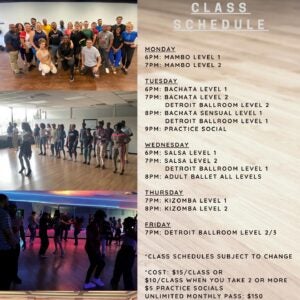Dance has changed my life. Specifically Latin dance. I started taking lessons when I was going through breast cancer treatment in 2018. It was something I had always wanted to do so I went for it. I even set a goal to perform for my family and friends on my birthday and 1 year cancer-free anniversary & I did it!

Courtesy: Shannon McGee
For me, it’s not just about being carefree and getting lost in the music, but also the sense of community you feel. And because I am so passionate about it, people are always asking me where they can take lessons. So, since it’s National Dance Week I thought I would ask some friends at A2 Movimiento Latino in Ann Arbor to give a quick salsa lesson for you to follow along in the video below. Then you can decided if you’d like to take more classes. I have listed their studio info below, but if you are not in the Ann Arbor area I have also posted other dance studios around Metro Detroit for you to get those hips moving at. So, lets get to this lesson!
History of Salsa
Now that you’ve got through the lesson, I must note that salsa is music before its a dance. The music genre and dance style originated in the 1960s and 70s in the Caribbean, specifically in Cuba and Puerto Rico. It was heavily influenced by various Afro-Caribbean rhythms such as Son, Mambo, and Cha Cha. One major figure in it’s history is Celia Cruz, a Cuban-American singer who became known as the “Queen of Salsa.” Her bold vocals and energetic performances helped to popularize salsa music around the world. When immigrants from these countries moved to New York City in the 70s, they brought the music with them and it quickly gained popularity in the salsa clubs of the city. Over time, the dance style evolved and so did the music. As salsa spread throughout the world, it began to incorporate elements of other styles such as jazz and rock.
The 1980s saw a resurgence of interest in salsa, with new salsa clubs opening up. Salsa also became a popular genre to crossover into mainstream pop music, with artists like Gloria Estefan and Marc Anthony gaining worldwide success.
Today, salsa remains a popular dance style and music genre around the world. With its lively and energetic beats, salsa music is sure to get your heart racing and your feet moving. It continues to evolve and incorporate new elements, and remains an important part of Latin American culture. So next time you’re at a salsa club, remember the rich history and cultural significance behind this lively and vibrant genre!



